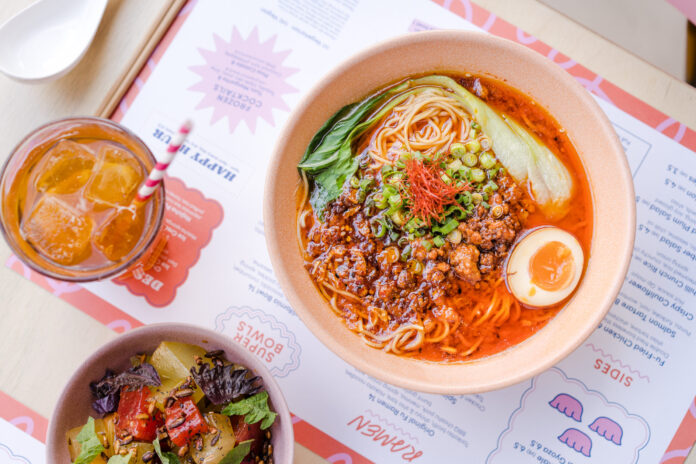Ideal for those looking to diversify deliciously.
The cost of food and energy has risen significantly in 2022, and many Brits are understandably looking for the most cost-effective ways to maintain a healthy and balanced diet for their families.
Indeed, we all have those gratifying, go-to family meals when money and time are tight. But if you’ve found the that kids are getting tired of your famous Shepherd’s Pie or you’re simply keen to expand your repertoire and introduce more healthy options into the household, then rest assured, you can provide variety and nutrition in spades with a little planning.
Even if you’re already a wizard in the kitchen, there are a few simple things you can do to ensure your meal planning is gentle on your purse and your energy consumption, all the while being heavy on both deliciousness and nutritional value.
All it takes is a little foresight and preparation; here are 6 tips for healthy, thrifty family meal prepping, IDEAL for those looking to diversify deliciously.
The Virtues Of Frozen Foods
We all know the beautifully comforting feeling of knowing that you have a homemade family meal in the freezer, ready to lift out, warm through and enjoy when you’ve had a busy day and not much time to cook.
Give yourself the gift of that feeling more frequently by spending a free afternoon on Saturdays or Sundays cooking up a few batches of lasagna, parmigiana mezzaluna, a black bean chilli or hearty stew ready for the week ahead. Alternatively, simply double up the size of the dinner you’re cooking one evening and freeze the remainder for a later date.
The virtues of having frozen veggies and fruit in the freezer shouldn’t be overlooked either. Many chefs say, for instance, that frozen peas are actually better than the freshly podded sort. Equally useful is a bag of frozen spinach, which is far more economical (both financially and in terms of space saving) than the fresh stuff; a frozen bag contains several equivalent bags of the fresh stuff, all condensed into a cube that you could fit in your hand!
Sometimes, it’s actually more nutritious that way; frozen at the point of picking, with all their nutrients intact. It just makes sense.
Of course, you’ll want to freeze everything correctly to avoid spoilage, which would rather nullify your lofty aims of nurturing a more thrifty, sustainable kitchen. Freezer safe containers are great for batch-cooked meals, but if you have loose items, using shrink wrap then a layer of foil can help keep freezer burn at bay.
Read: 7 tips on freezing food properly

Reacquaint Yourself With The Building Blocks Of A Balanced Diet
To design a thrifty, healthy menu of meals for the week, it’s first important to remind yourself of the building blocks of a balanced diet. That way, you can ensure the whole family is getting the nutrition they need, without overestimating everyone’s portion size.
The NHS recommends that you base meals around a starchy carbohydrate, such as pasta, potatoes or rice, preferably in their whole grain form and ideal for a slow, consistent release of energy. Of course, that much repeated ‘five-a-day’ mantra should the absolute minimum amount of fruit and vegetables you aim for; ideally, seven a day is better.
Don’t fret if this feels like a huge undertaking. Instead, simply throw an extra piece of fruit or vegetables into each meal. So, that’s a sliced banana or a handful of goji berries over your breakfast cereal, some sliced carrot in your tuna melt at lunch, and a handful of that frozen spinach we mentioned earlier, chucked into your chickpea curry tonight! Every little helps.
Experts suggest that the size of protein on your plate should be roughly equivalent to the size of a palm or a deck of cards, with that protein primarily comprising of eggs, fish (especially the oily stuff), beans and pulses. Finally, you should include a little dairy in your diet, via milk or cheese, and keep well hydrated with water, too.
Before Heading To The Shops, A Quick Inventory
If you want to save money, planning is key. Before you go grocery shopping, check your fridge, freezer and larder and plan your meals around any ingredients you already have.
A thorough analysis of what’s lurking in the darker corners of the cupboards will give you inspiration, help you use up stuff nearing its use-by-date and ensure that you don’t buy items which you already have plenty of. Because as the professionals like to say, ‘FIFO’ (that’s in ‘first in, first out’ to us laypeople) is key to reducing kitchen waste and making the most of the leftovers, too. Which brings us to…
Get Creative With Leftovers
If you make a little too much of something, don’t throw it away. Simply pop it in the fridge and use it for lunch the next day. This will save you even more time and money too, as you will be able to cut back on the lunch supplies. In fact, making your dinners with leftovers in mind is a smart, savvy move for keeping costs low and saving you prep time, too.
Check out these tips on what to do with the bits that you normally throw away to broaden your horizons on the potential of what’s lurking in your compost bin and beyond!
Use Your Appliances Wisely
It’s neither kind to your bank balance nor the environment to have your oven on for long stretches or several hobs ticking for the afternoon just to make dinner. Instead, diversify the way you use your appliances for thrifty results.
Anything from bread makers, slow cookers, pressure cookers, rice and vegetable steamers, right through to old technologies like halogen ovens can all make life easier and more efficient. Whilst it costs money to buy kitchen devices like these, they can save a great deal of money over their lifetime.
Did you know that many foodstuffs can be cooked in a microwave? It is possible to buy special microwave cooking bowls for a wide range of products, from rice and pasta right through to eggs and bacon. It is even possible to make delicious cakes in the microwave!
Read: 11 essential kitchen gadgets to take your cooking to the next level
Even the way you boil water matters; placing a lid on a pan of boiling water when cooking things like rice, pasta or vegetables reduces heat escape by physically keeping heat inside the pan. This means you can reduce the amount of energy required to maintain optimum cooking temperatures.
Include The Whole Family In The Shopping
Finally, a word to the wise. If you don’t want to have to make 15 different meals a day, include the entire family in the decision making process when you’re organising your thoughts on what to buy and cook for the week ahead.
Giving over a little autonomy at this stage will result in the whole household having a responsibility for the meals ahead, and will cut back on the constant ‘what’s for dinner?’ enquiries, too! What’s more, you’ll be teaching your children a valuable lesson on budgeting and healthy eating, which they’ll find so useful when they finally fly the nest!





